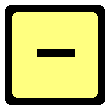 |
 |
PUNCTUATION |
|||||
|
|
|||||||
|
Hyphen
Hyphens are used to JOIN words and to SPLIT words.
Because the English language continues to develop, new words are constantly being created and gaining currency. Often, rather than invent a completely new combination of letters, new words are made by combining (parts of) existing words.
five-a-side heavy-duty pick-me-up
Such "join-words" may eventually, by common usage, become accepted as part and parcel of the language and may lose the hyphen.
headhunter postmortem (although post-mortem is still in use) nonverbal (although non-verbal is still in use)
A recent dictionary is essential for reference.
It should not normally be necessary to invent such "join-words", though it may help to clarify what you mean to say - rather than using complex (and perhaps clumsy) phrases.
Hyphens are also used to indicate that a word has been SPLIT, usually because it will not fit into the space available at the end of a line. Words that are divided in this way should be divided at the end of a syllable. The hyphen remains attached to the first part of the word in order to indicate to the reader that there is more to follow. (Word-processing software, which makes it possible to justify text, may herald the demise of this practice.)
|
|||||||
|
Introduction - Capital letters - Full stops - Question Marks - Exclamation marks - Abbreviations - Contractions - Commas - Speech marks (Quotation marks - Inverted comas) - Possessive apostrophes - Colons - Semi-colons - Brackets - Hyphens - Dashes - Obliques (slashes)
|
|||||||
|
|
|||||||
